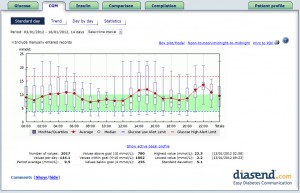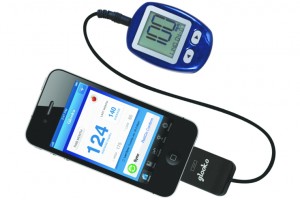New software solutions that communicate between differing brands of meters, monitors, and pumps make downloading a patient’s glucose data less time consuming for both physician and patient.
Imagine the following: you are caring from someone with a chronic, 24/7 disease where patients are asked to self-administer a potentially deadly drug every day, and you are only given twenty minutes with your patient a few times a year.
Oh, that’s right — you don’t have to imagine it. It’s type 1 diabetes.
The Problem
A physician can only do so much for someone with type 1 diabetes in a short office visit. David Ahn, MD, a clinical instructor of endocrinology at UCLA, knows this burden well. “In my endocrinology practice, type 1 diabetes easily represents my biggest time management challenge,” he says. “Unfortunately, it’s almost a given that these visits will either run over time or end with some topics left unaddressed.”
Ahn’s words capture the whirlwind of challenges confronting endocrinologists seeing patients with diabetes. For one, the patient population is growing quickly; the International Diabetes Federation (IDF) has predicted that by 2035, the number of people with diabetes will near 600 million, a roughly 50% increase relative to its 2014 estimate of 400 million. Meanwhile, there is a shortage of endocrinologists. According to studies from the 2014 Center for Disease Control National Diabetes Statistic Report and The Journal of Clinical Endocrinology & Metabolism, there is one endocrinologist for every 4,117 diabetes patients in the U.S. The cost of care has also become a huge problem for patients and the healthcare system; according to the IDF, diabetes expenditures in the U.S. reached $612 billion in 2014. In short, endocrinologists have less time and fewer resources for patients than ever before.
Data Downloading
One aspect of care that often proves troublesome is data downloading. At the American Association of Diabetes Educators 2014 meeting, a poll revealed that only 5% of the 400 attendees worked with physician providers who routinely download continuous glucose monitors (CGM) and pump data. “We are constantly pressured to do more in shorter visits,” Ahn says. “Something has to give, and it’s often the downloading of glucose data.”
Historically, the challenge of data downloading has been that information on blood glucose meters (BGM), CGMs, and insulin pumps have been handled in a very siloed way. Companies have designed devices to work only with proprietary hardware and software, making it inconvenient to download in the first place and even more difficult to integrate data from different devices (e.g., a pump and a meter).
“It is difficult to convince physicians that downloading actually improves care and saves time in the long run. This is especially true for those providers who were not introduced to the benefits of downloading in their training.”
— Irl Hirsch, MD, professor of medicine at the University of Washington School of Medicine in Seattle, endocrinologist at the University of Washington
As a result, the process of downloading glucose data can be time-consuming and frustrating. Endocrinologists do not have time to fumble with what is often unwieldy software to download these data. This sentiment is well captured by Irl Hirsch, MD, professor of medicine at the University of Washington School of Medicine in Seattle, and an endocrinologist at the University of Washington. “It is difficult to convince physicians that downloading actually improves care and saves time in the long run,” he says. “This is especially true for those providers who were not introduced to the benefits of downloading in their training. And for those who do understand the benefits of downloading, they work in clinics or offices without an infrastructure to do it efficiently and the frustration can be just as great.”
A Solution
Hirsch’s dilemma is a reminder that providers need convenient data download and interpretation solutions. This is where data management platforms come in; these “device-agnostic” systems reflect a growing trend in diabetes. They refer to software and hardware solutions that help download and consolidate data from multiple BGMs, CGMs, and insulin pumps into a single, standardized report. While currently available software and cables are often not interoperable, device agnostic data systems solve this problem by providing a single hardware/software solution that can download and integrate data from multiple devices.
In recent years, three companies have emerged with the goal of making data access easier and more convenient. After all, having this data is key to clinical decision-making.They provide a way of looking at what actually happened, not just what patients can remember.



Focusing on the Patient
While we have largely focused on providers, patients need more convenient data downloads as well. After all, they can enhance self-management and allow patients to begin to own their diabetes. The need for better solutions is well evidenced by data from the T1D Exchange Clinic Registry. This registry is made up of 26,000+ individuals with type 1 diabetes who range in age, at time of enrollment, from less than one year to 93 years. Even in this group that represents some of the most engaged type 1 patients, more than 50% of pump/BGM/CGM users never upload their data, and less than 10% upload their data more than once per week. Many patients may be weighing the decision of whether to upload their data and concluding that the hassle is too great.
Data uploading platforms have the potential to facilitate better decision-making, tighten patient-provider feedback loops, and inform more holistic self-management. They represent a new tool in the diabetes toolkit.
Of course, these platforms don’t solve the all the challenges confronting diabetes treatment and management, but they can make those challenges a little bit more manageable.
—Varun Iyengar is an associate at Close Concerns, a healthcare information company located in San Francisco. He writes about diabetes technology and digital health.

